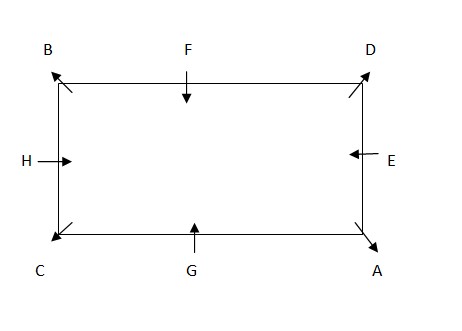Question
If G is made to face the opposite direction, who would
sit on his immediate left? Study the following information carefully to answer these questions carefully. A, B, C, D, E, F, G and H are sitting around a square table in such a way that four of them sit at four corner of the square while four sit in the middle of each of the four sides. The ones who sit at the four corners face outside while those who sit in the middle of the sides face the centre of the table. D sits third to the right of G. G faces the centre. E sits third to the left of C. C does not sit in the middle of the sides. Only one person sits between E and F. F is not an immediate neighbour of C. H faces the centre. A, is not an immediate neighbour of F.Solution
We have provided with the information, D sits third to the right of G. G faces the centre . E sits third to the left of C. C does not sit in the middle of the sides. C can sit at two places either on the immediate left of G or at the immediate right of G. Case. 1 – When C sits on the immediate right of G  Case.2 – When C sits on the immediate left of G
Case.2 – When C sits on the immediate left of G  Only one person sits between E and F. F is not an immediate neighbour of C. Case 1- F will sit on the right of E. H faces the centre. A, is not an immediate neighbour of F.
Only one person sits between E and F. F is not an immediate neighbour of C. Case 1- F will sit on the right of E. H faces the centre. A, is not an immediate neighbour of F.  In this case A will become an immediate neighbour of F which will make this case wrong. We will continue with case 2. Case 2- F will sit on the right of E. Only place left for B is on immediate right of F. Thus the final arrangement is;
In this case A will become an immediate neighbour of F which will make this case wrong. We will continue with case 2. Case 2- F will sit on the right of E. Only place left for B is on immediate right of F. Thus the final arrangement is; 
Which article emphasizes the provision of opportunities for education and just and humane conditions of work and maternity relief?
Deen Dayal SPARSH Yojana is related with which field?
Identify the flag bearer for India at the Paris 2024 Olympics Closing Ceremony.
What is the full form of ‘SDG’?
Which dynasty ruled the Vijayanagara Empire at the time of the Battle of Talikota?
Who has been appointed as the 25th Director General of the Indian Coast Guard?
The working principle of an electrical transformer is based on which concept?
A new policy of paramountcy was initiated by which of the following Governor General?
Which city will host the G20 Agricultural group meeting under India’s G20 presidency in June 2023?
Who won the Sahitya Akademi Award 2022 for Assamese language?


